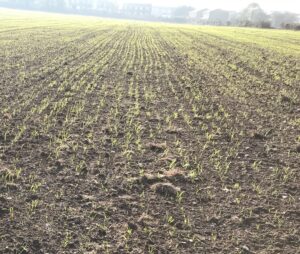Now that 2022 crops are harvested and in the barn, it’s time to focus on this autumn’s cropswhich appear to be doing well so far with plenty of soil moisture.
This is a key time to protect the plants and give them their best chance of getting throughthe winter so that they can develop well in the spring.
The mild October temperatures have led to high levels of aphids in cereals, and diseasesappearing in oilseed rape.
Mild and moist conditions have allowed a promising start to many herbicides programmesbut the conditions have also been ideal for weed growth so post-emergence treatments maybe needed in many areas to ensure control.
Here at Life Scientific, we have products which can help with some of these issues.
OILSEED RAPE DISEASE CONTROL
According to AHDB’s phoma forecast model ( https://ahdb.org.uk/phoma-leaf-spot-forecast ),autumn 2023 has seen the earliest risk of phoma pressure for some years. Based on weatherdata (rainfall and temperature) the model predicts when phoma levels may reach 10%around the country. This year, the predicted infection level ranged from late September tomid to late October, depending on geographical location. Phoma is actually caused by two closely related pathogens, Leptosphaeria maculans and Leptosphaeria iglobosahe, with the former showing as pale circular spots containing smallblack dots (pycnidia), and the latter showing as darker spots with fewer or no pycnidia.
Although the leaf spots don’t cause much damage, stem cankers can form if the pathogenmoves from the leaf to the stems. This can lead to lodging, early senescence and up to0.5T/Ha yield loss due to restriction of water and nutrient movement around the plant.
Timing of fungicides is important for effective control, with a first spray targeted when thecrop reaches 10-20% of plants with leaf spots (depending on the resistance rating of thevariety).
The wet weather in the third week of October meant that a number of crops were not able tobe sprayed at the optimum timing. If an application has not yet been made, it is critical tocheck your crop now and assess the phoma risk, applying an appropriate fungicide for thedisease. Where pressure remains high and reinfection occurs, a second application should bemade for best control, and the need for a follow-up spray to continue to protect the cropshould be considered this year.
A second spray can also have the benefit of helping to protect against light leaf spot ( Pyrenopeziza brassicae). Infections of light leaf spot tend to show up later in the autumn asthe typical pale patches with white spots around the edge. The disease can be very damagingif untreated, with possible yield losses of 1T/Ha.For best control, a fungicide spray should be applied before symptoms appear. As a secondspray may be required for phoma this year, it is worth using a product with activity againstboth phoma and light leaf spot.Life Scientific has a range of products approved for autumn disease control in oilseed rape touse in your programmes.
DIFENOSTAR (containing difenoconazole) is a cost-effective choice for phoma control.
AURELIA (containing prothioconazole) has activity against both phoma and light leaf spot. Alternatively, ESKER or ORASO PRO (containing prothioconazole plus tebuconazole) alsohave activity against both diseases, whilst tebuconazole is known to have some growthregulation activity in the crop. See the labels for full approval details, including dose rates and timings.
BARLEY YELLOW DWARF VIRUS
This mild autumn seems to have been one which suits cereal aphids and, if not treated, couldlead to BYDV symptoms in the spring.
The virus, transmitted by Bird cherry-oat aphids (Rhopalsiphum padi) and Grain aphids(Sitobion avenae) infects plants in the autumn, although symptoms don’t tend to show upuntil the spring.
Timing of control is important to make the most of your insecticide spray.
Application should be targeted against the mobile second generation aphids as these are theones that move and spread the virus to new plants. The most effective application timing iswhen accumulated air temperatures above 3 degrees C reach 170 day degrees (T-Sum 170)after emergence of the crop.
AHDB’s BYDV management tool ( https://ahdb.org.uk/bydv)
allows you to input your own cropinformation to give a risk personal to your farm.
As well as knowing when to spray, it is useful to know what species of aphid you have as someGrain aphids are known to have a level of resistance to pyrethroids.
The Rothamsted Research Insect Survey bulletins in early October showed that the majorityof aphids caught in the suction trap network were Bird-cherry oat aphids, and the percentageof cereal-colonising aphids was much higher than the 10 year average(
https://insectsurvey.com).
Life Scientific’s product, LAMBDASTAR contains 100g/l of lambda-cyhalothrin and is approvedfor the control of aphid vectors of BYDV in winter wheat, winter barley, winter oats and durumwheat. It should be used at the full rate of 50ml/Ha.
Visit Life Scientific’s website to see the approved label and tank-mix options.


